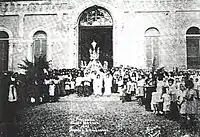| Dipolog Cathedral | |
|---|---|
 Dipolog Cathedral in late 2019 | |
.svg.png.webp) Dipolog Cathedral Location in Mindanao .svg.png.webp) Dipolog Cathedral Location in the Philippines | |
| 8°35′10″N 123°20′45″E / 8.586002°N 123.345736°E | |
| Location | Dipolog, Zamboanga del Norte |
| Country | Philippines |
| Denomination | Roman Catholic |
| History | |
| Status | Cathedral |
| Founded | 1896 |
| Dedication | Our Lady of the Most Holy Rosary |
| Architecture | |
| Functional status | Active |
| Architectural type | Church building |
| Style | Eclectic |
| Administration | |
| Archdiocese | Ozamiz |
| Diocese | Dipolog |
| Clergy | |
| Bishop(s) | Severo Caermare |
Dipolog Cathedral (Cebuano: Katedral sa Dipolog; Filipino: Katedral ng Dipolog), canonically recognized as the Our Lady of the Most Holy Rosary Cathedral Parish (Cebuano: Katedral sa Balaang Birhen sa Santo Rosario; Filipino: Parokyang Katedral ng Mahal na Birhen ng Kasanto-santuhang Rosaryo), is a Roman Catholic church located in Estaka, Dipolog, Zamboanga del Norte in the Philippines. The cathedral is the seat of the Roman Catholic Diocese of Dipolog.[1] It is situated in the city of Dipolog, the capital city of the Philippine province of Zamboanga del Norte, some 715 kilometres (444 miles) south of Manila.
History


Dipolog was formerly a barrio of Dapitan.[2] In April 1894, the construction of the church of Dipolog was begun while the first mass within the completed church was held in June 1894.[3] The parish of Dipolog was founded on June 30, 1896[1][3] with Fr. Esteban Yepes, a Jesuit, serving as its first parish priest.[4] The first church altar of Dipolog was designed by José Rizal while he was exiled in Dapitan.[2][5] The features of the church are its wooden ceiling, wooden bas relief of the four Evangelists, massive adobe stone walls, and reredos, among others.[4] In 1913, Dipolog formally became a separate town from Dapitan.[2] The church became a cathedral when the Diocese of Dipolog was canonically founded in 1967.[1] Reforms brought by the Second Vatican Council changed the church's reredo into a simple one with vertical design and a central bell tower being added to the façade. In 1986, the nave's main columns were removed under the helm of Msgr. Salvador Mora. As part of centennial anniversary of Dipolog's parish foundation in 1996, the cathedral's main reredo was restored with carved marble under Msgr. Esteban Gaudicos. Bishop Jose Manguiran, Dipolog's second bishop, led the cathedral interior renovation in 2007, the original walls restoration in 2008, and the 2009 renovation of the façade. Then Manila cardinal-archbishop Gaudencio Rosales led the blessing of the renovated façade in May 2009.[4]
Present day
In 2021, the cathedral was designated as one of the 500 Jubilee Churches as part of the activities for the quincentennial of Philippine Christianity.[6]
References
- 1 2 3 "Cathedral of Our Lady of the Holy Rosary Dipolog City, Zamboanga del Norte, Zamboanga Peninsula, Philippines". GCatholic. Archived from the original on May 1, 2021. Retrieved December 15, 2021.
- 1 2 3 "Socio Economic Profile". Dipolog city government. Archived from the original on October 11, 2021. Retrieved December 15, 2021.
- 1 2 "Dipolog City History". Dipolog city government. Archived from the original on October 11, 2021. Retrieved December 15, 2021.
- 1 2 3 "Our Lady Of The Most Holy Rosary Cathedral". Gmaps. Retrieved December 15, 2021.
- ↑ "Altar ng simbahan na idinisenyo ni Dr. Jose Rizal". GMA News (in Filipino). August 24, 2013. Retrieved December 15, 2021.
- ↑ "List of Jubilee Churches as PH marks 500 years of Christianity". Rappler. 6 March 2021. Retrieved 20 December 2021.
External links
 Media related to Dipolog Cathedral at Wikimedia Commons
Media related to Dipolog Cathedral at Wikimedia Commons- Facebook page